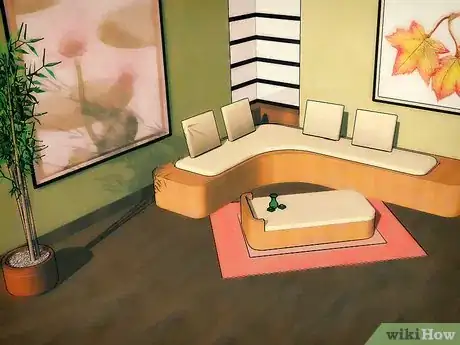This article was co-authored by Juli Roland. Juli Roland is a Color Specialist and the Founder of PaintColorHelp.com, one of the first companies in Dallas, Texas metro area that provides in-home color consultations and helps clients create paint color schemes. Juli has over 15 years of commercial and residential color consulting experience, including seven years as a custom-matcher in the paint industry. She earned her certification in color strategy from Camp Chroma and is a member of the Inter-Society Color Council. She has a BA in Advertising from Texas Tech University.
There are 9 references cited in this article, which can be found at the bottom of the page.
This article has been viewed 174,036 times.
You've heard thrilling tales of excitement and relaxation, set between walls of taupe and accented beautifully with maroon or a deep royal blue. These stories keep you up at night, dreaming of the perfect color scheme for your own living room. Whether guided by the mood you’re hoping to create or a tendency to surround yourself with tried and true thematic influences, you’ll benefit from an understanding of how to match colors and determine dominant, secondary, and accent hues. You can choose the perfect paint, furniture, and accent colors by following a few simple guidelines.
Steps
Deciding on the Ambiance You Want
-
1Develop an idea of the mood you want to create. Ambiance refers to the tone, character, and atmosphere of an environment.[1] Ambiance can strongly affect the mood that a room imbues. Think about the role you want the room to play in your life. Among the most important factors to consider are the following:
- What do you use the room for (watching TV, entertaining, reading, etc.)?
- What time of day you tend to use the living room?
- Are you hoping for the room to energize or relax you?
- Do you usually allow sunlight in through the windows?
-
2Take advantage of natural light. There are certain color combinations meant for supremely sunny spaces. If the living room will be occupied during the day and is particularly well-lit by the sun, color the walls with saturated jewel tones or earthy shades.
- Bright tones, like a sapphire blue or emerald green look great in the sun.
- Similarly, dark earthy shades only work in spaces with a lot of natural light, since the light prevents the living room from looking too dark.
- Note that these colors tend to be overpowering in lower light, and should not be used in rooms that are not well lit.
- Keep in mind that if you put up wallpaper in a room with lots of natural light, it will fade over time.
- If you have a really dark room, remove objects that block natural light like scones, drapes, and old-fashioned window toppers.[2]
Advertisement -
3Lighten up a dark room with sunny hues. If, on the other hand, your living room doesn’t get a good amount of sunlight, or you’ll spend more time in your living room during the evening, there are certain colors than can help brighten the space up.
- Ivory and buttercup yellow can make a living room that does not receive much light look brighter, especially when these colors are prominently used.
- A space with low light can be made to look bright and cheery by using light greens and blues as well.
-
4Create a warm space with warm tones. A similar, though distinct, aspect to consider is a room’s warmth. Deep reds, burnt oranges, and nearly all shades of gold and brown can be used to create a cozy, glowing space that is especially appropriate for a living room.[3]
- These combinations are great for living rooms that are used both during the day and in the evening, as they emphasize comfort over energy, but aren’t too dark for daytime use.
- Avoid using bright shades of red or orange as dominant or secondary colors, though, since these colors tend to carry too much energy and may seem overwhelming in excess.[4]
- Earth tones, such as deep yellows, browns, and rusty reds, can warm up the space and look great in every light.
-
5Relax the room with cool tones. On the other hand, blues, cool violets, and grays are especially useful in creating a calm atmosphere capable of soothing you, your family, and your guests.[5]
- If your living room tends to have occupants predominantly in the evening, cooling tones may be best, especially if you tend to relax in this space.
- Green is a good choice if you want to create a grounding and calming effect.
-
6
-
7Opt for darker colors in a large room. Darker colors make a space seem more enclosed, so they shouldn’t be used in small rooms. If you have a large, open space, however, feel free to choose a deep hue, such as navy blue or plum.[8]
- Generally, you should avoid painting an entire room a dark color. Stick with a single accent wall instead.
Sticking with Proven Palette Approaches
-
1Follow the 60-30-10 rule. Regardless of the colors you choose, it’s helpful to plan how much space each color will account for. As a rule of thumb, 60% of your living room should be a dominant color, 30% should be a secondary color, and 10% should be an accent color.
- Choose dominant and secondary colors you're especially comfortable with. Know that your dominant color choice will greatly impact the room's feel. Don't choose a dominant or secondary color that you are not absolutely sure of.
- Only use bold colors as accent colors. A punch of powerful color can do wonders to the energy and character of a space. Make this sort of impact with your accent color. For a sense of vitality, make your accent color the brightest of your palette.
- Ensure that all 3 colors coordinate well with one another. Group your chosen colors together in a small trial area before committing to painting and decorating the whole room.
- You might want to use a neutral color as a base, like beige or gray, as they are versatile and classic.
-
2Match the color scheme of your furnishings. For instance, if you have modern furniture and decorations, you will probably be better off with a modern color scheme of white, black, and gray than you would be with a traditional color scheme filled with rich hues.
- Alternatively, if you have older or more traditional furniture, use bright, modern colors for paint and accents to update the space.
- If your furnishings share a color scheme, complimenting that color with a secondary or accent color will tie the room together quite well.
-
3Stick with white for a simple, clean option. White is the safest bet there is. While some may prefer a more interesting dominant color, there’s no denying that all-white or mostly-white color schemes can create a very clean, crisp living room.
- You can choose from a wide variety of “white,” such as off-white, cream, eggshell, grey-white, or antique white.
-
4Use subtle shades for a contemporary color theme. Contemporary colors include subtle, muted shades of natural colors that can help create a calm atmosphere while still allowing you to inject a bit of personal style into the space.[9]
- Light browns and soft grays can readily serve as dominant colors, and slightly darker shades of the same colors make great secondary and accent colors.
-
5Opt for neutral colors to modernize your living room. One popular approach when updating a living space is to make it feel more modern. Certain colors combinations help facilitate a more modern feel. In general, create a modern living room by using neutral colors.
-
6Combine neutrals and rich colors for a traditional color scheme. Traditional living room designs use deep shades of elegant colors to invoke an almost formal classiness in your living room. Use neutral colors for walls and other dominant swaths of space, but weave in secondary and accent hues in rich shades of red, blue, or brown.
- You can even make the room seem more regal and traditional by choosing a “historical” color like colonial yellow, hunter green, pearl gray, or Prussian blue.[12]
-
7Employ a transitional color scheme if you enjoy traditional and modern decor. A transitional color scheme combines the colors commonly found in both contemporary and traditional spaces.[13] Incorporate contemporary shades of tan and vanilla with rich hues like maroon or navy blue.
- Taking a transitional approach is a great option, as it imbues a sense of both fun and class. If you like both traditional and modern decor, transitional might be the best choice for you.
Going Your Own Way with Color Selection
-
1Familiarize yourself with the color wheel. In order to know how to balance colors, you should have a general idea of where they are in relation to one another on the wheel. Typically, complementary colors—colors found on polar opposite ends of the wheel—coordinate well with one another.[14]
-
2Pair complementary colors. Since complementary colors are effectively opposites, they play off of one another in order to make one another "pop" or stand out.[15] Examples of complimentary colors include; red and green, orange and blue, or yellow and violet.
- Due to the vibrant nature of complementary colors, you may want to consider using muted shades of the colors you favor. Bright shades of complementary colors have a tendency to assault the eyes, but muted shades can add a pleasant buzz of energy to your living room.
-
3Compare swatches before painting or buying furniture and accents. If you feel uncertain about how a prospective color scheme might look, look at paint cards, swatches of fabric, or other color samples side by side. Bring swatches and paint cards home to your living room, and hold them up in the spaces you’re considering using them.
- Take advantage of this mini test run before you invest time and money in paint and furnishings.
- Paint cards are readily available at both hardware stores and paint suppliers, while fabric swatches can be found at furniture stores. Either can be sent directly to your home by manufacturers.
-
4Stick with the colors you love. Instead of trying to create a living room that looks impressive, create a living room that feels comfortable. It’s your living room after all, and should be decorated according to what you like. Further, the more comfortable you feel in it, the happier you’ll be showing it off.
- Go with your gut. If a certain color makes you feel happy or peaceful, use it!
-
5Get inspiration from a prominent piece in the room. If you’re having trouble deciding on a color scheme, look no further than the objects you intend to keep in the room. Prominent pieces of art or furniture can greatly complement (and be complemented by) the color scheme you choose. Planning for what you intend to have in the room will also ensure that your color scheme coordinates with the most noticeable pieces in your living room.
- If you have a patterned couch, for instance, snatch colors from that pattern to create your overall color scheme.
- If you have a piece of artwork that you want to dominate the space, play to its prominence with the colors you choose. You might match your accent color to a prominent color featured in the piece, for instance.
- You could also get inspiration from a sculpture or accessory. Bring the item to the store with you to help you match paint, window treatments, or other furnishings to it.
Expert Q&A
Did you know you can get expert answers for this article?
Unlock expert answers by supporting wikiHow
-
QuestionHow can I incorporate an accent color into my living room?
 Juli RolandJuli Roland is a Color Specialist and the Founder of PaintColorHelp.com, one of the first companies in Dallas, Texas metro area that provides in-home color consultations and helps clients create paint color schemes. Juli has over 15 years of commercial and residential color consulting experience, including seven years as a custom-matcher in the paint industry. She earned her certification in color strategy from Camp Chroma and is a member of the Inter-Society Color Council. She has a BA in Advertising from Texas Tech University.
Juli RolandJuli Roland is a Color Specialist and the Founder of PaintColorHelp.com, one of the first companies in Dallas, Texas metro area that provides in-home color consultations and helps clients create paint color schemes. Juli has over 15 years of commercial and residential color consulting experience, including seven years as a custom-matcher in the paint industry. She earned her certification in color strategy from Camp Chroma and is a member of the Inter-Society Color Council. She has a BA in Advertising from Texas Tech University.
Certified Color Specialist My rule is the bolder the color, the smaller the area. So if you gravitate to strong color (as I tend to), introduce it first in small touches. A lamp, a curtain, a pillow. These items are easily changed if you tire of them, and don’t usually require a huge outlay of cash. Want more color? Go a little bigger––try a colorful rug or side chair.
My rule is the bolder the color, the smaller the area. So if you gravitate to strong color (as I tend to), introduce it first in small touches. A lamp, a curtain, a pillow. These items are easily changed if you tire of them, and don’t usually require a huge outlay of cash. Want more color? Go a little bigger––try a colorful rug or side chair. -
QuestionWhich colour is best for a living room?
 Katherine TlapaKatherine Tlapa is an interior designer, currently working as a Design Specialist for Modsy, a design service based in San Francisco. She also runs her own DIY Home Design blog, My Eclectic Grace. She received her BFA in Interior Architecture from Ohio University in 2016.
Katherine TlapaKatherine Tlapa is an interior designer, currently working as a Design Specialist for Modsy, a design service based in San Francisco. She also runs her own DIY Home Design blog, My Eclectic Grace. She received her BFA in Interior Architecture from Ohio University in 2016.
Interior Designer
-
QuestionWhich color is the best accent for a black and white living room?
 Community AnswerYou can choose your favorite color because just about every color goes with black and white. I would choose turquoise but it really depends whether you want a dark or light finish.
Community AnswerYou can choose your favorite color because just about every color goes with black and white. I would choose turquoise but it really depends whether you want a dark or light finish.
References
- ↑ http://www.dictionary.com/browse/ambiance
- ↑ Juli Roland. Certified Color Specialist. Expert Interview. 27 March 2020.
- ↑ http://www.hgtv.com/design/decorating/color/decorating-with-warm-rich-color-tones-pictures
- ↑ Juli Roland. Certified Color Specialist. Expert Interview. 27 March 2020.
- ↑ Juli Roland. Certified Color Specialist. Expert Interview. 27 March 2020.
- ↑ Juli Roland. Certified Color Specialist. Expert Interview. 27 March 2020.
- ↑ http://www.housepaintingtutorials.com/painting-rooms.html
- ↑ http://www.housepaintingtutorials.com/painting-rooms.html
- ↑ http://www.houzz.com/ideabooks/3964727/list/9-fashionably-cool-living-room-color-palettes
- ↑ http://www.benjaminmoore.com/en-us/for-your-home/rooms-by-color/modern-living-room-mix
- ↑ Juli Roland. Certified Color Specialist. Expert Interview. 27 March 2020.
- ↑ https://www.bobvila.com/articles/2240-historic-paint-colors/
- ↑ http://budgetdecorating.about.com/od/designstyles/a/Decorating-In-The-Transitional-Style.htm
- ↑ http://www.thisoldhouse.com/toh/photos/0,,20161202,00.html
- ↑ http://www.thisoldhouse.com/toh/photos/0,,20161202,00.html
About This Article
If you’re redecorating your living room, there are a few things to consider to help you choose the right colors. If you get a lot of natural light in the room and you use it during the day, consider going for bright tones like sapphire blue or emerald green. If your living room has little natural light and you use it a lot in the evenings, you might be better off with sunny hues like ivory and buttercup yellow. To make your living room feel warmer and more comfortable, choose warm tones like deep reds, burnt oranges, golds, or browns. For a more relaxing, fresh feel, go for cool tones like blues, cool violets, and grays. For more tips from our Interior Design co-author, including how to complement your furniture with your living room colors, read on!




































































